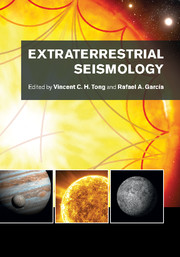Book contents
- Frontmatter
- Contents
- List of contributors
- Preface
- Acknowledgements
- List of abbreviations
- Planetary seismology: High risk, high return
- A bright outlook for helio- and asteroseismology
- Part I Observation and space missions
- Part II Data and physical parameters
- Part III Modeling approaches
- Part IV Discoveries of physical structures and processes
- Part V Interdisciplinary research involving planetary and astrophysical sciences
- Part VI Interdisciplinary research involving terrestrial seismology
- References
- Index
Planetary seismology: High risk, high return
Published online by Cambridge University Press: 05 July 2015
- Frontmatter
- Contents
- List of contributors
- Preface
- Acknowledgements
- List of abbreviations
- Planetary seismology: High risk, high return
- A bright outlook for helio- and asteroseismology
- Part I Observation and space missions
- Part II Data and physical parameters
- Part III Modeling approaches
- Part IV Discoveries of physical structures and processes
- Part V Interdisciplinary research involving planetary and astrophysical sciences
- Part VI Interdisciplinary research involving terrestrial seismology
- References
- Index
Summary
Except for specialists, planetary seismology refers first to Earth seismology, and stimulates thoughts about earthquakes, tsunamis, and all such rare and brutal events that everyone knows by experience and/or fears. According to etymology, seismology shakes and shocks our bodies and our minds. According to semantics, all languages make the difference between “superficial” and “deep” things, so that everyone turns out to be a seismologist, encouraged to prefer a deep to a superficial analysis, to get to the bottom of things, to look at an issue in more depth, to delve into something, to get to the root of the matter, to seek out the underlying issues…
We have basically a 2D topological experience of the Earth since we live on it and are attached to its surface. Of course, in tunnels and by plane, we are invited to explore the third dimension, a thin envelope in fact, so shallow with respect to the Earth radius. Even this Earth radius is an ethereal concept (sorry for the hiatus), since we lack normal circumstances where we can simply feel that the Earth is not as flat as a pancake. When the Earth was a pancake, there was a great debate about the nature of its edge. In a 3D spherical view, defining and measuring the Earth radius implies necessarily prospecting the medium between the surface and the center.
Hidden signatures
The favorite activity of a planetary seismologist consists in seeking to look well below the planetary surface, as done by Athanasius Kircher, a German Jesuit (1601–1680), in his model of the Earth's interior. Volcanoes were seen as outlets of the Earth's internal fires. Similarly, any trace on a planetary surface can be related to properties of the interior structure. On the Moon, the absence of surface faulting indicates tectonic inactivity.
- Type
- Chapter
- Information
- Extraterrestrial Seismology , pp. 1 - 4Publisher: Cambridge University PressPrint publication year: 2015



